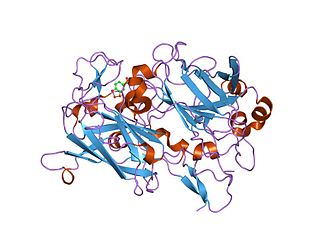This page is based on this
Wikipedia article Text is available under the
CC BY-SA 4.0 license; additional terms may apply.
Images, videos and audio are available under their respective licenses.
Ard, ARD, Ards or ARDS may refer to:

4-Hydroxyphenylpyruvate dioxygenase (HPPD), also known as α-ketoisocaproate dioxygenase, is an Fe(II)-containing non-heme oxygenase that catalyzes the second reaction in the catabolism of tyrosine - the conversion of 4-hydroxyphenylpyruvate into homogentisate. HPPD also catalyzes the conversion of phenylpyruvate to 2-hydroxyphenylacetate and the conversion of α-ketoisocaproate to β-hydroxy β-methylbutyrate. HPPD is an enzyme that is found in nearly all aerobic forms of life.

Hawkinsinuria, also called 4-Alpha-hydroxyphenylpyruvate hydroxylase deficiency, is an autosomal dominant metabolic disorder affecting the metabolism of tyrosine. Normally, the breakdown of the amino acid tyrosine involves the conversion of 4-hydroxyphenylpyruvate to homogentisate by 4-Hydroxyphenylpyruvate dioxygenase. Complete deficiency of this enzyme would lead to tyrosinemia III. In rare cases, however, the enzyme is still able to produce the reactive intermediate 1,2-epoxyphenyl acetic acid, but is unable to convert this intermediate to homogentisate. The intermediate then spontaneously reacts with glutathione to form 2-L-cystein-S-yl-1,4-dihydroxy-cyclohex-5-en-1-yl acetic acid (hawkinsin).
Catechol dioxygenases are metalloprotein enzymes that carry out the oxidative cleavage of catechols. This class of enzymes incorporate dioxygen into the substrate (biochemistry). Catechol dioxygenases belong to the class of oxidoreductases and have several different substrate specificities, including catechol 1,2-dioxygenase, catechol 2,3-dioxygenase, and protocatechuate 3,4-dioxygenase. The active site of catechol dioxygenases most frequently contains iron, but manganese-containing forms are also known.

β-Hydroxy β-methylglutaryl-CoA (HMG-CoA), also known as 3-hydroxy-3-methylglutaryl-CoA, is an intermediate in the mevalonate and ketogenesis pathways. It is formed from acetyl CoA and acetoacetyl CoA by HMG-CoA synthase. The research of Minor J. Coon and Bimal Kumar Bachhawat in the 1950s at University of Illinois led to its discovery.

Indoleamine-pyrrole 2,3-dioxygenase (IDO or INDO EC 1.13.11.52) is a heme-containing enzyme that in humans is encoded by the IDO1 gene. It is one of three enzymes that catalyze the first and rate-limiting step in the kynurenine pathway, the O2-dependent oxidation of L-tryptophan to N-formylkynurenine, the others being IDO2 and tryptophan 2,3-dioxygenase (TDO).

Enoyl-CoA hydratase (ECH) or crotonase is an enzyme that hydrates the double bond between the second and third carbons on 2-trans/cis-enoyl-CoA:

Isovaleryl-coenzyme A, also known as isovaleryl-CoA, is an intermediate in the metabolism of branched-chain amino acids.

3-Methylcrotonyl-CoA or β-Methylcrotonyl-CoA is an intermediate in the metabolism of leucine.

3-Methylglutaconyl-CoA (MG-CoA), also known as β-methylglutaconyl-CoA, is an intermediate in the metabolism of leucine. It is metabolized into HMG-CoA.
In enzymology, a trimethyllysine dioxygenase (TMLH; EC 1.14.11.8) is an enzyme that catalyzes the chemical reaction
Acireductone dioxygenase (Ni2+-requiring) (EC 1.13.11.53) is an enzyme that catalyzes the chemical reaction

In enzymology, tryptophan 2,3-dioxygenase (EC 1.13.11.11) is a heme enzyme that catalyzes the oxidation of L-tryptophan (L-Trp) to N-formyl-L-kynurenine, as the first and rate-limiting step of the kynurenine pathway.

The human ADI1 gene encodes the enzyme 1,2-dihydroxy-3-keto-5-methylthiopentene dioxygenase.

Dioxygenases are oxidoreductase enzymes. Aerobic life, from simple single-celled bacteria species to complex eukaryotic organisms, has evolved to depend on the oxidizing power of dioxygen in various metabolic pathways. From energetic adenosine triphosphate (ATP) generation to xenobiotic degradation, the use of dioxygen as a biological oxidant is widespread and varied in the exact mechanism of its use. Enzymes employ many different schemes to use dioxygen, and this largely depends on the substrate and reaction at hand.

α-Ketoisocaproic acid (α-KIC) and its conjugate base, α-ketoisocaproate, are metabolic intermediates in the metabolic pathway for L-leucine.

Tyrosinemia type III is a rare disorder caused by a deficiency of the enzyme 4-hydroxyphenylpyruvate dioxygenase, encoded by the gene HPD. This enzyme is abundant in the liver, and smaller amounts are found in the kidneys. It is one of a series of enzymes needed to break down tyrosine. Specifically, 4-hydroxyphenylpyruvate dioxygenase converts a tyrosine byproduct called 4-hydroxyphenylpyruvate to homogentisic acid. Characteristic features of type III tyrosinemia include mild mental retardation, seizures, and periodic loss of balance and coordination. Type III tyrosinemia is very rare; only a few cases have been reported.
2-Hydroxy-3-keto-5-thiomethylpent-1-ene dioxygenase may refer to:
Acireductone synthase (EC 3.1.3.77, E1, E-1 enolase-phosphatase) is an enzyme with systematic name 5-(methylthio)-2,3-dioxopentyl-phosphate phosphohydrolase (isomerizing). This enzyme catalyses the following chemical reaction












